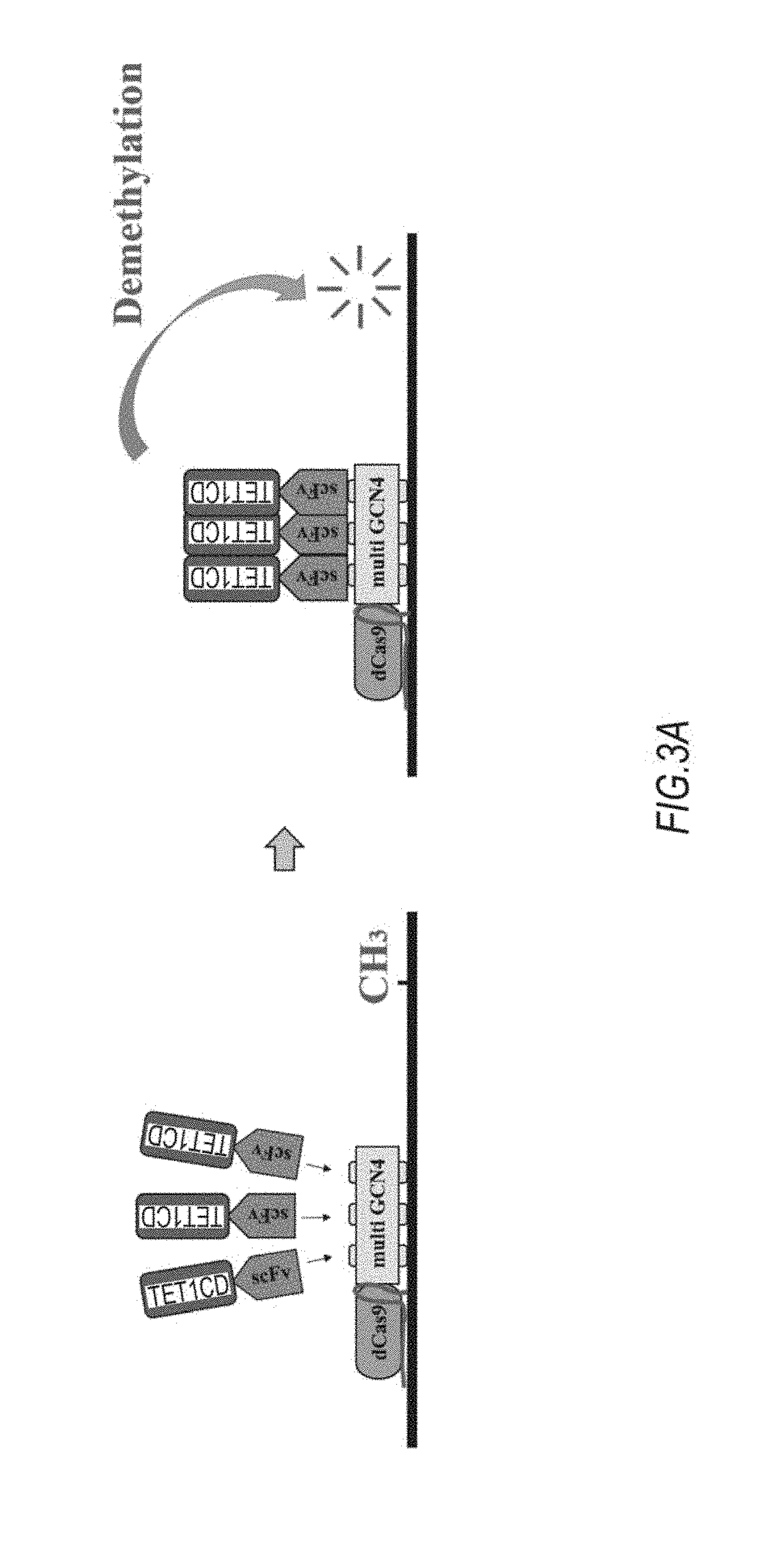DNA methylation editing kit and DNA methylation editing method
a technology of methylation and editing kit, which is applied in the direction of immunoglobulins, peptides, transferases, etc., can solve the problems of low degree of demethylation and doubts about safety concerns
- Summary
- Abstract
- Description
- Claims
- Application Information
AI Technical Summary
Benefits of technology
Problems solved by technology
Method used
Image
Examples
example 1
Demethylation of Target Using TET1CD
[0080]
[0081]A dCas9-TET1 catalytic domain (CD) fusion protein expression vector (pCAG-dCas9TET1CD) was produced by fusing cDNA encoding codon-optimized S. pyogenes Cas9 (dCas9) as a catalytically inactive nuclease to a catalytic domain in the N-terminus of human TET1CD (System 1). A dCas9 fragment was amplified from Addgene plasmid 48240 by PCR. A TET1CD fragment was amplified from human cDNA by PCR.
[0082]The dCas9 fragments of Systems 1 to 4 in FIG. 1 were amplified from Addgene plasmid 60903 by PCR. The amino acid sequence of used GCN4 was EELLSKNYHLENEVARLKK (SEQ ID NO: 1). Linker sequences between GCN4 tire GSGSG (SEQ ID NO: 2: System GSGSGGSGSGSGGSGSGGSGSG (SEQ ID NO 3: System 3), and GSGSGCSGSGGSGSGGSGSGGSGGSGSGGSGSGGSGSGGSGSG (SEQ ID NO: 4: System 4). A GFP fragment was amplified from Addgene plasmid 60904. An ScFv fragment was also amplified from Addgene plasmid 60904. All the fusion proteins were expressed under the control of a CAG promo...
example 2
Methylation of Target Using Dnmt3b
[0105]The m2 site of H19 was methylated using System 3 (linker 22aa) in order to introduce methylation into a target. Experiments were conducted using (1) Dnmt3b, (2) Dnmt3bNLS, and (3) Dnmt3bNLS_N662R instead of TET1CD (FIG. 7). (1) is a De novo methylase Dnmt3b, (2) is obtained by adding NLS (nuclear localization signal) to the C terminus of the Dnmt3b of (1), and (3) is obtained by changing the 662nd amino acid of (2) from asparagine (N) to arginine (R). This amino acid substitution has been reported to improve methylation activity (Shen L et al. below). The plasmids used are as follows.
[0106](1) Dnmt3b: pCAG-scFvGCN4sfGFPDnmt3bF (SEQ ID NO: 41)
[0107](2) Dnmt3bNLS: pCAG-scFvGCN4sfGFPDnmt3bFNLS (SEQ ID NO: 42)
[0108](3) Dnmt3bNLS_N662R: pCAG-scFvGCN4sfGFPDnmt3bS1 (SEQ ID NO: 43)
[0109]Only cells into which genes were introduced and which emitted fluorescence were isolated based on fluorescence of GFP by a cell sorter 2 days after introduction of the...
PUM
| Property | Measurement | Unit |
|---|---|---|
| Digital information | aaaaa | aaaaa |
| Catalyst | aaaaa | aaaaa |
Abstract
Description
Claims
Application Information
 Login to View More
Login to View More - R&D
- Intellectual Property
- Life Sciences
- Materials
- Tech Scout
- Unparalleled Data Quality
- Higher Quality Content
- 60% Fewer Hallucinations
Browse by: Latest US Patents, China's latest patents, Technical Efficacy Thesaurus, Application Domain, Technology Topic, Popular Technical Reports.
© 2025 PatSnap. All rights reserved.Legal|Privacy policy|Modern Slavery Act Transparency Statement|Sitemap|About US| Contact US: help@patsnap.com



